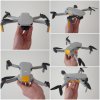Here's a question for both sides of the debate:
In still air, and if the MM's speed over ground was not capped, in which direction could the drone achieve the fastest speed (over ground)? (eg, forwards, diagonally forwards, sideways, backwards etc.)
Assume there are no issues with the drone like bent props, weaker motors.
I've taken some crude photos of the MM for visual reference of surface area when tilted. I should have been more scientific and had the angle of the camera relative to drone set to show a 30 deg tilt, and kept the scale exactly the same.

I am fully in agreement that tacking (zigzagging) into the wind will never make more progress upwind than simply flying directly into the wind (@sar104 and @Meta4 's point). However it's not quite so clear what orientation to have the drone in to minimise its drag (kind-of @fpvaddict 's point, if I've understood right?)
Th MM seems to cap its SOG to max 13m/s so I'm not sure how some valid tests could be done? Perhaps some insight could be gained from motor speeds after doing a few runs along a set path with the drone body in various headings?
It "might" just have least drag when flying backwards!!??
In still air, and if the MM's speed over ground was not capped, in which direction could the drone achieve the fastest speed (over ground)? (eg, forwards, diagonally forwards, sideways, backwards etc.)
Assume there are no issues with the drone like bent props, weaker motors.
I've taken some crude photos of the MM for visual reference of surface area when tilted. I should have been more scientific and had the angle of the camera relative to drone set to show a 30 deg tilt, and kept the scale exactly the same.

I am fully in agreement that tacking (zigzagging) into the wind will never make more progress upwind than simply flying directly into the wind (@sar104 and @Meta4 's point). However it's not quite so clear what orientation to have the drone in to minimise its drag (kind-of @fpvaddict 's point, if I've understood right?)
Th MM seems to cap its SOG to max 13m/s so I'm not sure how some valid tests could be done? Perhaps some insight could be gained from motor speeds after doing a few runs along a set path with the drone body in various headings?
It "might" just have least drag when flying backwards!!??
Last edited:




 Tacking is pointless for making progress against a headwind, and drag does not affect this.
Tacking is pointless for making progress against a headwind, and drag does not affect this.






